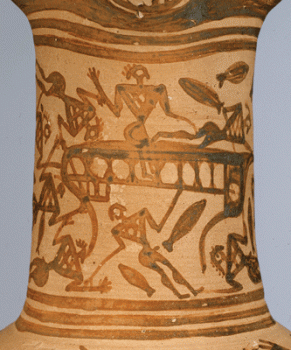American Journal of Archaeology | The Journal of the Archaeological Institute of America
You are here
The Shipwreck of Odysseus: Strong and Weak Imagery in Late Geometric Art
January 2011 (115.1)
The Shipwreck of Odysseus: Strong and Weak Imagery in Late Geometric Art
The once-popular interpretation of a well-known scene on a Late Geometric oinochoe in Munich as the shipwreck of Odysseus is now regularly dismissed: like other ambiguous scenes of late eighth-century art, it has been banished from the ranks of early mythological narratives. This article proposes that the scene be restored to the ranks of possible mythological images and defends the premise that myth was the subject of some Late Geometric artists. It also suggests that the most important thing we can do with a Late Geometric scene is not to assign it to one of the standard categories of “myth” (Sagenbild), “genre” (Lebensbild), or “the generalized heroic” but to new categories that transcend those distinctions. Images may be defined as “strong” or “weak” depending on their uniqueness, complexity, and especially the concreteness of description, whether they depict scenes of myth, genre, or real (as opposed to universalized) life—a subject that may be more common and significant than is usually thought. This approach emphasizes the exceptionalism, variety, and originality of Late Geometric imagery, and the Late Geometric artistís interest in the description of both the heroic and real worlds.
The Shipwreck of Odysseus: Strong and Weak Imagery in Late Geometric Art
By Jeffrey M. Hurwit
American Journal of Archaeology Vol. 115, No. 1 (January 2011), pp. 1–18
DOI: 10.3764/aja.115.1.0001
© 2011 Archaeological Institute of America


